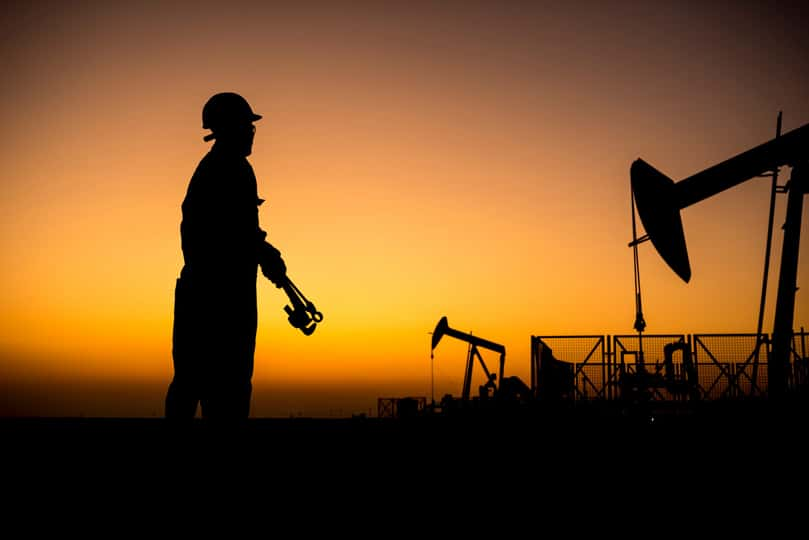Policymakers around the world are working toward limiting temperature increases to 1.5% above pre-industrial levels. To achieve this feat, countries are transitioning to cleaner energy sources. Despite the undergoing transition, the demand for traditional energy sources such as crude oil and gas is unlikely to slow down in the distant future.
In fact, many analysts expect oil and gas demand to rise in the long run. Given the industry’s steady growth prospects, it could be wise to add energy stocks Halliburton Company (HAL - Get Rating), Helmerich & Payne, Inc. (HP - Get Rating), and Delek US Holdings, Inc. (DK - Get Rating) to one’s watchlist.
Before diving deeper into the fundamentals of these stocks, let’s understand what’s shaping the industry’s prospects.
Several countries and companies around the world have pledged to achieve net zero emission targets. This has put the focus on clean energy initiatives. Despite these initiatives, demand for oil and gas is expected to grow in the long term. JPMorgan expects world oil demand to reach 106.9 mbd by 2030.
Christyan Malek, J.P. Morgan’s Global Head of Energy Strategy and Head of EMEA Oil & Gas Equity Research, said, “We are turning bullish now as we envisage an emerging supply-demand gap beyond 2025, coupled with strengthening bottom-up sector fundamentals.”
Lately, oil has been stuck in a range due to fears of a slowdown in global economic growth and the lack of demand from the biggest oil importer, China. However, oil demand is expected to rise as the International Monetary Fund raised its forecast for global economic growth, upgrading the outlook for the United States and China, citing faster-than-expected easing of inflation.
Higher global economic growth is likely to lead to higher demand for commodities, especially crude oil. Another reason why oil has been stuck in a range is due to higher non-OPEC production, especially by the United States, which has helped offset the production cuts in place by OPEC+. The OPEC+ has oil production cuts of 2.2 million bpd in place for the first quarter of 2024.
However, that is likely to change as the U.S. Energy Information Administration (EIA) cut its forecast for domestic oil growth this year by 120,000 barrels per day (bpd) to 170,000 bpd, which is considerably lower than last year’s output increase of 1.02 million bpd. The EIA had previously forecasted that crude production would rise by 290,000 bpd this year.
Moreover, OPEC+ crude output fell 340,000 bpd in January, registering its steepest fall in six months due to voluntary cuts by some members and protests at Libya’s largest oil field. OPEC+ is likely to decide early next month whether these production cuts will be extended into the second quarter.
Oil prices are also expected to get a boost due to the ongoing conflict in the Middle East and the attacks carried out at the Red Sea by Iran-aligned Houthis, as it has the potential to disrupt commodity prices and supply chains. World oil demand is set to reach a record 103 million barrels per day this year.
The IEA has forecast that global oil demand will rise by 1.2 million barrels per day this year compared to 2023, raising its outlook for the third consecutive month. It expects world oil demand to grow by 1.8 million barrels per day in 2025, driven by global economic growth and solid activity in China.
Furthermore, given the continued dependence on oil and gas, companies related to oil and gas drilling, production, transportation, evaluation, and maintenance are expected to thrive. The global oilfield services market is projected to grow at a CAGR of 5.6% to reach $421.31 billion by 2030.
Considering these conducive trends, let’s discuss the fundamentals of the featured energy stocks.
Halliburton Company (HAL - Get Rating)
HAL provides products and services to the energy industry worldwide. It operates in two segments: Completion and Production and Drilling and Evaluation.
In terms of the trailing-12-month levered FCF margin, HAL’s 7.12% is 25.9% higher than the 5.65% industry average. Likewise, its 0.96x trailing-12-month asset turnover ratio is 74.9% higher than the industry average of 0.55x.
On the other hand, HAL’s 22.07% trailing-12-month EBITDA is 36.4% lower than the 34.70% industry average. Likewise, its 18.94% trailing-12-month gross profit margin is 59% lower than the 46.19% industry average. Furthermore, the stock’s 11.46% trailing-12-month net income margin is 10.8% lower than the industry average of 12.85%.
HAL’s total revenue for the fourth quarter ended December 31, 2023, increased 2.8% year-over-year to $5.74 billion. Its total operating income rose 8.4% over the prior year quarter to $1.06 billion. The company’s adjusted net income attributable to the company increased 17.2% year-over-year to $769 million. Also, its adjusted net income per share came in at $0.86, representing an increase of 19.4% year-over-year.
Analysts expect HAL’s EPS for the quarter ending March 31, 2024, to increase 3.6% year-over-year to $0.75. Its revenue for the same quarter is expected to decline marginally year-over-year to $5.67 billion. It surpassed the consensus EPS estimates in each of the trailing four quarters. Over the past nine months, the stock has gained 17% and declined 11.9% over the past six months to close the last trading session at $35.03.
HAL’s POWR Ratings reflect its bleak prospects. It has an overall rating of C, equating to a Neutral in our proprietary rating system. The POWR Ratings assess stocks by 118 different factors, each with its own weighting.
It is ranked #14 out of 51 stocks in the Energy – Services industry. It has a C grade for Growth, Value, Stability, Sentiment, and Quality. Click here to see HAL’s rating for Momentum.
Helmerich & Payne, Inc. (HP - Get Rating)
HP provides drilling services and solutions for exploration and production companies. The company operates through North America Solutions, Offshore Gulf of Mexico, and International Solutions segments. It also focuses on developing, promoting, and commercializing technologies designed to enhance the drilling operations, as well as wellbore quality and placement.
In terms of the trailing-12-month net income margin, HP’s 15.27% is 18.8% higher than the 12.85% industry average. Likewise, its 15.40% trailing-12-month Capex/Sales is 10.3% higher than the industry average of 13.96%.
On the other hand, HP’s 31.41% trailing-12-month EBITDA is 9.5% lower than the 34.70% industry average. Likewise, its 18.08% trailing-12-month EBIT margin is 14.4% lower than the 21.12% industry average. Furthermore, the stock’s 15.48% trailing-12-month Return on Common Equity is 20.2% lower than the industry average of 19.38%.
For the fiscal first quarter, which ended December 31, 2023, HP’s operating revenues declined 5.9% year-over-year to $677.15 million. Its operating income declined 14.4% over the prior-year quarter to $123.47 million. The company’s net income decreased 2% year-over-year to $95.17 million.
On the other hand, its total cash, cash equivalents, and restricted cash rose 2.8% year-over-year to $279.24 million. Also, its EPS came in at $0.94, representing an increase of 3.3% year-over-year.
Street expects HP’s EPS for the quarter ending March 31, 2024, to decline 32.2% year-over-year to $0.85. Its revenue for the quarter ending September 30, 2024, to increase 8.1% year-over-year to $713.04 million. It surpassed the Street EPS estimates in three of the trailing four quarters. Over the past nine months, the stock has gained 22.3% and declined 12% over the past six months to close the last trading session at $38.18.
HP’s uncertain outlook is reflected in its POWR Ratings. It has an overall C rating, equating to a Neutral in our proprietary rating system.
Within the Energy – Drilling industry, it is ranked #3 out of 15 stocks. It has a C grade for Value and Sentiment. To see the additional ratings of HP for Growth, Momentum, Stability, and Quality, click here.
Delek US Holdings, Inc. (DK - Get Rating)
DK engages in the integrated downstream energy business in the United States. The company operates through three segments: Refining, Logistics, and Retail. It serves oil companies, independent refiners and marketers, jobbers, distributors, utility and transportation companies, government, and independent retail fuel operators.
On February 2, 2024, DK announced that it was selected by the Department of Energy’s (DOE) Office of Clean Energy Demonstrations to negotiate a cost-sharing agreement in support of a carbon capture pilot project in the Big Spring refinery.
Delek US’s President and CEO said, “The selection of the Big Spring refinery validates its competitive advantage, solid operations, and the opportunities in our assets. Carbon capture is important for decarbonizing hard-to-abate sectors. This project will position Delek US as a strong leader in the energy transition while meeting our financial and other objectives for stakeholders and maintaining our disciplined approach to capital allocation.”
DK’s 3.54% trailing-12-month Return on Total Capital is 59.9% lower than the 8.82% industry average. Likewise, its 1.42% trailing-12-month EBIT margin is 93.3% lower than the 21.12% industry average. Furthermore, the stock’s 2.63% trailing-12-month Capex/Sales is 81.1% lower than the industry average of 13.96%.
On the other hand, in terms of the trailing-12-month asset turnover ratio, DK’s 2.13x is 288.4% higher than the 0.55x industry average.
DK’s net revenues for the fiscal third quarter ended September 30, 2023, declined 10.8% over the prior-year quarter to $4.75 billion. Its operating income decreased 324% year-over-year to $224.70 million. The company’s adjusted net income declined 38.6% year-over-year to $131.90 million. Also, its adjusted EPS came in at $2.02, representing a decline of 33.1% year-over-year.
On the other hand, its net cash provided by operating activities increased 232.3% year-over-year to $432.60 million.
For fiscal 2023, DK’s EPS is expected to decline 56.1% year-over-year to $3.22. Its revenue for the quarter ending March 31, 2024, is expected to decrease 22% year-over-year to $3.49 billion. It surpassed the consensus EPS estimates in each of the trailing four quarters. Over the past nine months, the stock has gained 31.2% to close the last trading session at $28.11.
DK’s bleak prospects are reflected in its POWR Ratings. It has an overall C rating, equating to a Neutral in our proprietary rating system.
It is ranked #17 out of 82 stocks in the Energy – Oil & Gas industry. It has a C grade for Stability and Quality. Click here to see the additional ratings of DK for Growth, Value, Momentum, and Sentiment.
What To Do Next?
43 year investment veteran, Steve Reitmeister, has just released his 2024 market outlook along with trading plan and top 11 picks for the year ahead.
Want More Great Investing Ideas?
HAL shares were trading at $34.93 per share on Friday morning, down $0.10 (-0.29%). Year-to-date, HAL has declined -3.37%, versus a 5.08% rise in the benchmark S&P 500 index during the same period.
About the Author: Dipanjan Banchur

Since he was in grade school, Dipanjan was interested in the stock market. This led to him obtaining a master’s degree in Finance and Accounting. Currently, as an investment analyst and financial journalist, Dipanjan has a strong interest in reading and analyzing emerging trends in financial markets. More...
More Resources for the Stocks in this Article
| Ticker | POWR Rating | Industry Rank | Rank in Industry |
| HAL | Get Rating | Get Rating | Get Rating |
| HP | Get Rating | Get Rating | Get Rating |
| DK | Get Rating | Get Rating | Get Rating |






